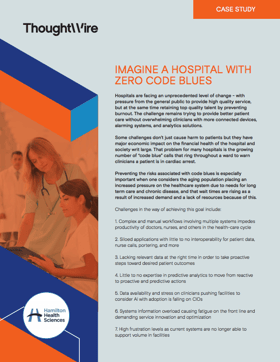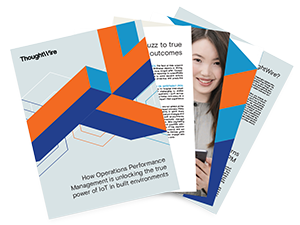What is Operations Performance Management (OPM)?
Operations Performance Management (OPM) is the process of making an organization’s lines of business function optimally and in-synch in order to meet critical key performance indicators (KPIs) or business goals.
OPM is usually accomplished through the use of software. OPM software allows organizations to bring together raw data from various business units and turn it into actionable insights quickly and smartly. It also enables the automated self-tuning of single or multiple assets. In other words, OPM software optimizes processes and throughput - making operations more efficient, agile and cost-effective.
OPM software has been traditionally used in manufacturing facilities but has more recently been applied in hospitals, office buildings, commercial real estate buildings and smart cities. In fact, the principles of OPM can be leveraged in any built environment containing processes, peoples, and things (like wifi-enabled devices) and that wants to optimize for efficiency and/or provide a better user experience.
How does Operations Performance Management (OPM) software work?
OPM software works by bringing together raw data generated within an organization. This could be data coming off of IoT devices and IoT sensors or data created by occupants, employees or managers. OPM software then uses machine learning, AI and algorithms, including cognitive reasoning, to determine appropriate actions to be taken based on consistent and unambiguous semantic information. At ThoughtWire, this process is powered by a digital twin and an incredibly fast in-memory graph database.
The results? OPM provides better information and analytics. It puts power in people’s hands, enabling them to take action. Moreover, OPM enables processes to self-tune or adjust automatically and precisely based on predefined rules. This eliminates the need for people to oversee certain time-consuming tasks.
OPM is more than just a dashboard and it goes beyond mere efficiency. It maximizes opportunities, connects the right people with the right information at the right time, and cuts through a variety of operational layers, data sources and organizational silos to transform buildings into smart environments.
How is OPM transforming the built environment?
OPM creates better business results by orchestrating people, systems and things in real-time. Furthermore, it unlocks the full growth potential of IoT by empowering people with operational intelligence and enabling predictive self-tuning of assets and processes.
In the built environment OPM does this by providing:
- Situational awareness -- the ability to see resource status/location, track KPIs and gain full visibility of operations.
- Operational intelligence -- the ability to optimize for availability, orchestrate workflows, schedule resources, communicate seamlessly and optimize building operations.
- Workflow transformation -- the ability to optimize throughput and intelligently automate workflows.
- Operations optimization and real-time actionable insights -- the ability to achieve a predictive warning system, intelligent alerts, and recommendations for optimal performance.
- New value -- the ability to enable user self-registration, optimize call routing, control environmental factors and improve communication across teams.
A good example of where OPM can make a difference is in hospitals.
By implementing OPM software in a hospital, administrators, doctors, and nurses can get powerful, real-time insight into patient health and workflows. Using sensors to monitor patients and coordinate equipment and staff, OPM offers a better way of analyzing processes and alerting the right people at the right time when immediate action is needed.
As a result, emergency room wait times can be reduced and patient flow can be improved -- thereby decreasing operational costs and enhancing the patient experience. Moreover, OPM software can predict and help prevent patient emergencies like cardiopulmonary or respiratory arrest, known as code blues. The result? More lives are saved.
In fact, one health care network that implemented OPM software in their hospitals saw a 61% reduction in code blue events. In another hospital, a 900% improvement in cost savings was measured after implementing OPM software to remove bottlenecks in patient flow.
OPM software in commercial real estate buildings and workplaces
Commercial real estate buildings and offices are another places where OPM software is transformational.
OPM software allows building operators to bring together previously unconnected systems -- from security to HVAC to wayfinding systems -- to gain new insights, optimize workflows and monitor processes remotely. It can also be used to give occupants more control over their own workspaces and environmental conditions, thereby enhancing the tenant experience.
By optimizing systems and connecting people, owners and operators can leverage OPM software to reduce costs, avoid future costs, increase occupancy rates and improve overall asset value. In fact, when implemented, OPM software can lower operating costs in some buildings by up to 88 cents per square foot per year.
In summary...
Operational Performance Management (OPM) is an approach to managing operations that not only transforms buildings but also transforms the experience of people within those buildings. From creating a better experience at work to saving people’s lives, OPM software is a game changer.
If you’re looking for a new way of optimizing and orchestrating people, process and things inside your building, OPM software just might be for you.






